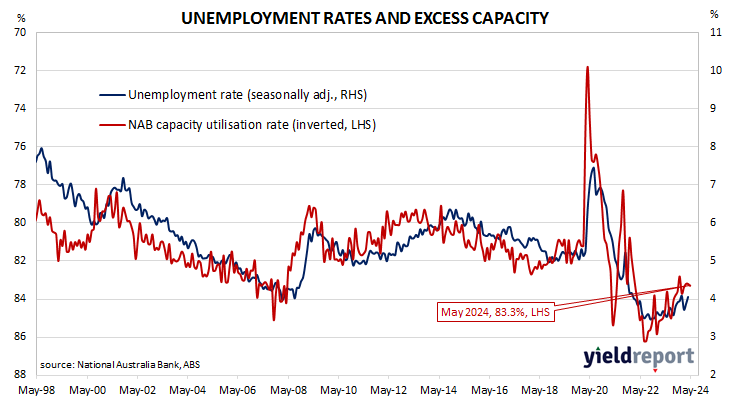Summary: Business conditions deteriorate slightly in May; business confidence also deteriorates, now well below average; NAB: suggests subdued economic activity continues; ACGB yields generally modestly higher; rate-cut expectations soften; NAB: inflation will continue to moderate only gradually; capacity utilisation rate ticks up, at elevated level.
NAB’s business survey indicated Australian business conditions were robust in the first half of 2018, with a cyclical-peak reached in April of that year. Readings from NAB’s index then began to slip and forecasts of a slowdown in the domestic economy began to emerge in the first half of 2019 as the index trended lower. It hit a nadir in April 2020 as pandemic restrictions were introduced but then improved markedly over the next twelve months and has subsequently remained at robust levels.
According to NAB’s latest monthly business survey of around 400 firms conducted in the last week and a half of May, business conditions deteriorated slightly and are now at a level which is in line with the long-term average. NAB’s conditions index registered 6 points, down 1 point from April’s reading.
Business confidence also deteriorated. NAB’s confidence index fell 5 points to -3 points, a reading which is well below the long-term average. Typically, NAB’s confidence index leads the conditions index by one month, although some divergences have appeared from time to time.
“Business confidence fell back into negative territory in May as conditions continued to gradually soften, suggesting the subdued economic activity seen in the Q1 GDP data has continued into Q2,” said NAB Chief Economist Alan Oster.
Australian Commonwealth Government bond yields generally moved modestly higher, although the 20-year yield jumped as it played catch-up from Friday. By the close of business, the 3-year ACGB yield had added 1bp to 3.98%, the 10-year yield had gained 3bps to 4.34% while the 20-year yield finished 10bps higher at 4.64%.
Expectations regarding rate cuts in the next twelve months softened by the end of the day. In the cash futures market, contracts implied the cash rate would remain close to the current rate for the next few months and average 4.315% through June, 4.31% in July and 4.325% in August. However, November contracts implied 4.31%, February 2025 contracts implied 4.265% while May 2025 contracts implied 4.16%, 16bps less than the current cash rate.
“Nonetheless, capacity utilisation remains above average and cost and price growth measures rose in the month, including retail price growth, which rebounded back up to 1.6% in quarterly terms,” Oster added. “This suggests that, while growth has slowed, the process of bringing supply and demand back into balance remains incomplete, reinforcing our expectation that inflation will continue to moderate only gradually from here.”
NAB’s measure of national capacity utilisation ticked up from 83.2% to 83.3%, a level which is quite elevated from a historical perspective. Seven of the eight sectors of the economy were reported to be operating at or above their respective long-run averages.
Capacity utilisation is generally accepted as an indicator of future investment expenditure and it also has a strong inverse relationship with Australia’s unemployment rate.



